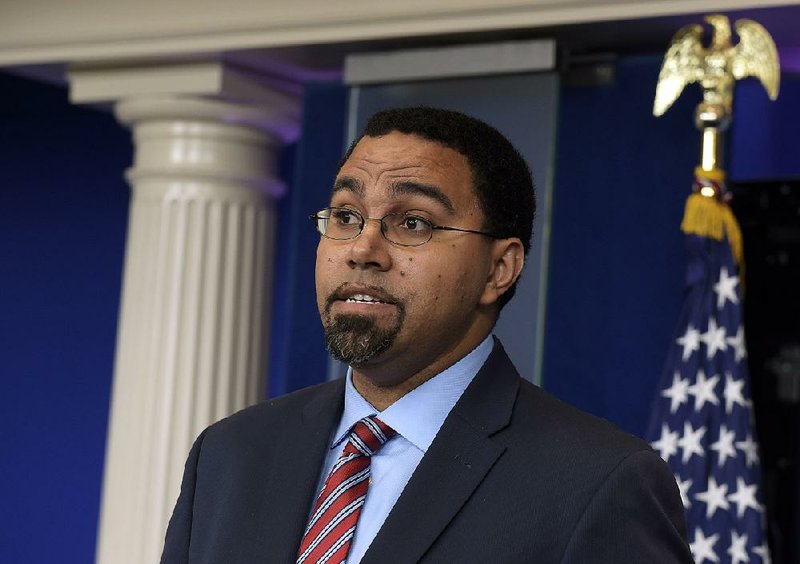WASHINGTON -- States will have more time to identify failing schools as part of new U.S. Education Department rules aimed at supporting troubled public schools and students who are struggling.
The rules, released Monday, provide a broad framework for states as they design new accountability systems to evaluate schools, to improve ones that aren't adequately educating students and to narrow achievement gaps. It's a key part of the Every Student Succeeds Act, a bipartisan education bill passed almost a year ago and signed into law by President Barack Obama to replace the No Child Left Behind Act.
Under the law, states may design accountability systems that consider measures beyond test scores and high school graduation rates. Those measures can include chronic absenteeism, access to Advanced Placement courses and school climate, and the states may decide how much weight to give to each of those indicators of success and others in their school ratings. But the states must measure the performance of all students, including "sub-groups of students" such as minority groups, children from low-income families, and special education students.
Education Secretary John King Jr. said the department considered concerns from states, Congress, civil-rights groups, educators and others in drafting the rules. The department released draft rules in May and made several key changes in response to more than 20,000 public comments.
"That feedback resulted in a better regulation," King said in a phone call with reporters Monday. "We've provided increased flexibility for states and districts in some key areas while ensuring civil-rights protections remained in place for our neediest students."
The draft rules required states and districts to identify schools in need of extra help by the 2017-18 school year, but Republicans and teachers unions called that timeline unrealistic. The final rules extend the timeline to the 2018-19 school year. Schools with "consistently underperforming" subgroups of students will have to be identified by the 2019-20 school year.
The revised rules clarify that states are only required to label schools with the categories specified in the law itself: those in need of "comprehensive" intervention, including the lowest-performing 5 percent of schools and high schools with graduation rates below 67 percent; those in need of "targeted" support, including those with low-performing subgroups of students; and schools with no special identification. States can also create more nuanced ratings if they wish.
Sen. Lamar Alexander, R-Tenn., and chairman of the Senate Health, Education, Labor and Pensions Committee, said he will review the final rules before deciding if Congress needs to intervene. Alexander -- a chief architect of the new education law -- said he would have moved to overturn the earlier version of the regulation "because it was not authorized by the new law, and included provisions specifically prohibited by the new law."
The law overhauling No Child Left Behind shifts significant control over education policy back to the states. Students will still be required to take annual math and reading tests in third through eighth grades and once in high school. But other measures of student growth and learning could be considered when evaluating school performance.
The accountability systems will have to provide an overall rating for schools but also specific information for parents and the public about how schools performed on the individual measures that states choose to incorporate into their evaluations.
Chris Minnich, executive director of the Council of Chief State School Officers, said it was clear the department listened to concerns from school chiefs across the country.
"We look forward to working with the new administration to offer states the guidance, flexibility and stability they need to create plans under this new law," Minnich said.
Randi Weingarten, president of the American Federation of Teachers, also praised many of the changes as "commonsense," but said the Obama administration did not go far enough in rolling back its rules regarding test participation.
The law requires that 95 percent of students take tests each year, and it includes an option that allows states to come up with their own method of dealing with low participation, as long as it is rigorous enough to fix the problem.
The draft rule had given states several options to choose from in addressing schools with large numbers of students who don't take annual standardized tests, a matter that has become a lightning rod in the so-called opt-out movement, in which parents refuse to allow their children to take tests. But all of the options involved substantial dings to the school's rating.
It's not clear what the incoming administration of President-elect Donald Trump might do with the regulation. Trump has pledged a smaller federal footprint in public education. Analysts have said Trump has the authority to rewrite the regulations entirely, giving states more leeway to handle school accountability, or his administration could simply decline to enforce the regulations.
States have to submit plans for their new accountability systems to the department by either April 3 or Sept. 18.
Information for this article was contributed by Jennifer C. Kerr of The Associated Press; and by Emma Brown of The Washington Post.
A Section on 11/29/2016
